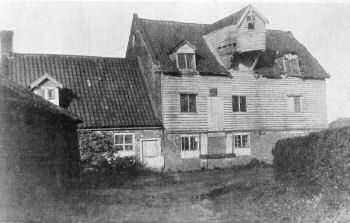 |
|
c.1935
|
|
Swafield Mill
River Ant / North Walsham & Dilham Canal |
 |
|
c.1935
|
|
Swafield water
mill was originally built of weatherboard with brick base and a Norfolk
pantiled roof. This was a small mill, being 3 storeys high with loft space.
The mill was actually in the parish of North Walsham although the mill
house was in Swafield. |
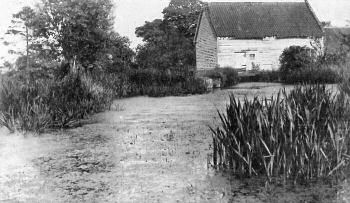 |
|
Mill dam c.1935
|
Indenture |
Assignment of Land and Bargain and Sale of Windmill, Tackle and Appurtenances in Southrepps. 1. William Seckar of Swafield, miller son of Isaac Secker of Heverland miller, deceased 2. Thomas Jourdan of Southrepps, miller 'Land then long since became vested through various conveyances in William Seckar' Windmill 'lately and new erected' with flour mill by William Seckar Consideration £210 8 October 1774 |
North Walsham, Nov. 20, 1783. |
|
To be Lett |
Royal Exchange Fire Insurance policy 144815 |
Thos. Roberts of Swaffield in the Co. of Norfolk, Miller. On Furniture in his Dwellg. House tiled fit. in Swaffield afsd. - £50. On the Water Wheel, Standing & Going Geers, Mill Stones, Wire Machines & Drefsing Mills in a Water Corn Mill Brick, Timber & tiled near - £50. On Utensils & Trade in the fame - £400. On Utensils & trade in a Stable tiled nr. - £50. Warranted to have no Kiln. 25th March 1795 |
To Millers |
Edward Press went on to run Gt Yarmouth Southtown Green Cap mill, where he was in 1853. |
To be SOLD by Private Contract |
To be Let With Possession at Old Michaelmas next |
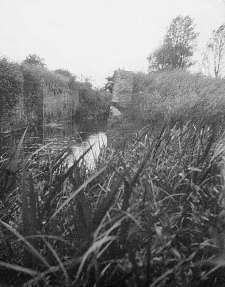 |
|
Swafield lock remains in 1928
|
To MERCHANTS, MILLERS, and CAPITALISTS |
To be Premptorily SOLD by AUCTION |
Pursuant to CVertain Orders of the Commissioners under a Commission of Bankrupt awarded and issued against JOHN WOOLSEY & JOHN SECKER of Great Yarmouth in the county of Norfolk, Wine & Spirit Merchants, Dealers & Chapmen and on the application of the Mortgagees the following ESTATES at teh respective places aforementioned. At the Bear Inn Bridge Foot, Great Yarmouth, on Thursday 8th September next at 11 o'c, by WALTER C. PETTINGILL Lot 1. All the capital new built WINDMILL situate in Southtown next Great Yarmouth, having a Brick Tower containing eleven floors, the lowest being 34 feet diameter, working four pair of stones, three flour mills and two jumpers, capable of manufacturing upon an average 120 quarters of wheat per week; also a convenient new built Dwelling house with stable, suitable offices and two acres of capital pasture land situate in Southtown aforesaid where the parochial charges are trifling and within 200 yards of Yarmouth Bridge and the Corn Market. The Mill is in full trade with good country and town connections. The above Estate is Leasehold for a term of 80 years of which 61 will be unexpired at Christmas next and is subject only to an annual rent of £20. Lot 2. All the capital Freehold Messuage with shop . . . And also at the King's Arms Inn, North Walsham On the aforesaid 8th day of September, at Six o'clock in the Evening, Lot 3. All that capital Dwelling-house, with convenient outbuildings, yard and garden, together with the Water-mill, Cottage, and Granaries adjoining, and about 16 acres of Arable and Meadow Land of the best quality, in the highest state of cultivation. And also a Wind-mill and about two roods and 30 perches of Arable Land. The above Premises are situate in Swafield and North Walsham, and are in full trade, and now in the occupation of Mr. Benjamin Postle Woollsey, as tenant from year to year. The Water_Mill, Cottage, Granaries, and about nine acres of the Land are Leasehold of the Bishop of Norwich, for a term of 21 years, commencing the 10th October, 1827, at an annual rent of 3l. 13s. 4d. The Mill commands a good head of water, and drives two pair of stones and two flour mills. The Dwelling-house, Out-buildings, Yard and Garden, and about five acres, three roods, and 22 perches of the Land are Freehold and pleasantly situated. The Wind-mill, which is in excellent repair, and two roods and 30 perches of Land are Copy-hold of the Manor of North Walsham about half a mile. This Estate offers either a desirable Investment for Money, or a good situation for an active Man of Business, having water carriage to the Port of Yarmouth, is within 16 miles of Norwich, one of North Walsham, and 26 of Yarmouth. And at the same time and place last mentioned, will be Sold by order of the Assignees of the said Bankrupt. A Place of Freehold Arable Land, situate in Swafield, near Swafield Bridge, leading over the North Walsham and Dilham Canal, containing about one acre and one rood, and is well calculated for Warehouses, Granaries, Coal and Timber Yards - Also one Share in the North Walsham and Dilham Canal. Further particulars may be had in London of Messrs. Amory and Coles, Solicitors, Throgmorton Street; Messrs. Swaine and C. Solicitors, Frederick's Place, Old Jewry; Mr. Lythgoe, Essex Street, Strand; and in the County, of Mr. Clowes, and Messrs. Sayers and Glasspool, Solicitors, Great Yarmouth. Norfolk Chronicle - 13th, 20th & 27th August 1831 |
 |
Norfolk Chronicle - 13th, 20th & 27th August 1831 |
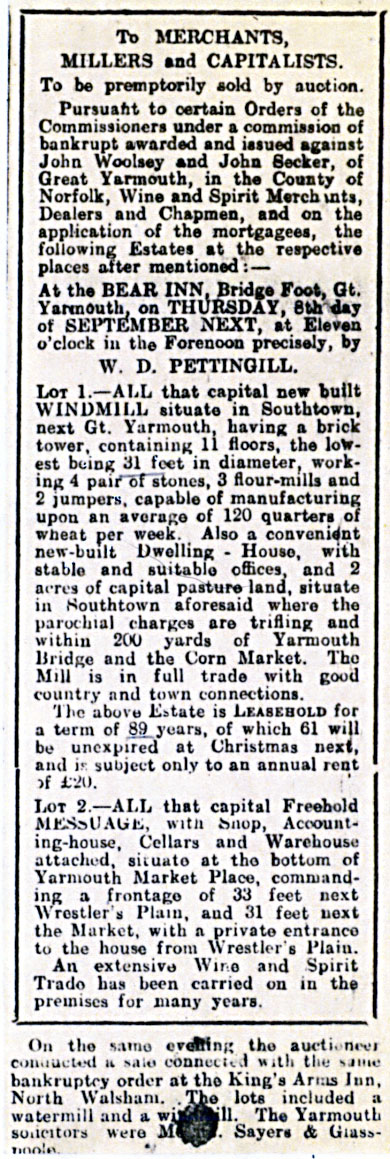 |
Yarmouth Windmill, H. B. Johnson, Mercury - 1831 |
To be Sold by Auction under a Commission of Bankrupt awarded against John Woollsey and John Secker of Great Yarmouth, wine and spirit merchants, dealers and chapmen, and on the application of the Mortgagees, at the Bear Inn, Bridge Foot, Great Yarmouth, on 8 September. |
To Millers, Merchants and others |
NOTICE |
H. P. Woollsey, Executrix |
| Norfolk Chronicle - 20th October 1860 |
Tithe Award 1843 |
||||
No. 987 |
Windmill, Yard & Pightle |
Arable |
0a. 2r. 30p. |
1/4d |
Robert Page married Benjamin Postle Woollsey's daughter Charlotte and took over the mill on the death of Benjamin Woollsey on 1st October 1860 after allegedly having fallen into the lock. In 1858 Robert Page was running Swanton_Abbott_towermill. |
NORTH WALSHAM |
SWAFIELD MILLS |
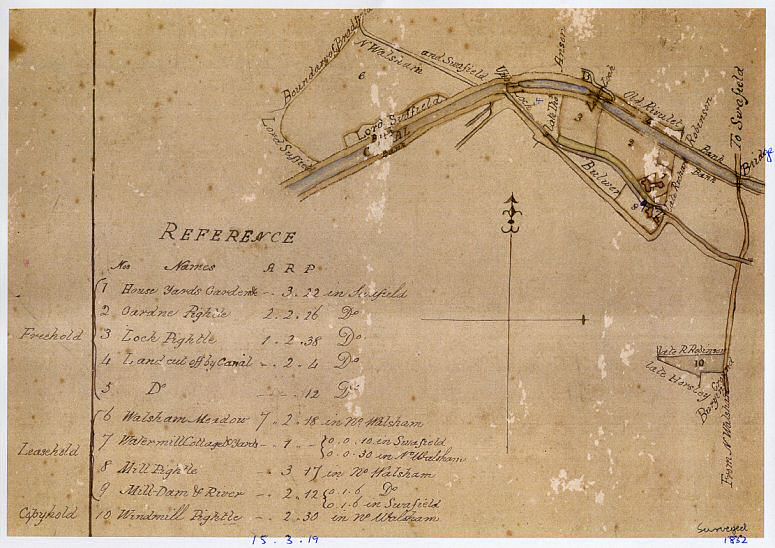 |
|
1832 survey map |
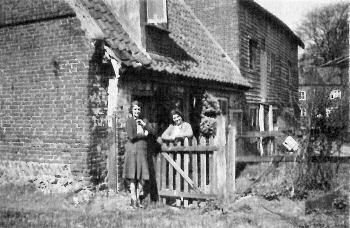 |
|
Ethel
Forbes & Eve Marsham c.1946
|
|
The Swafield mills have been sold by auction this week |
In the 18th century, they belonged to the Seckers, that interesting
family of Norfolk Quakers, whose most distinguished member was John Secker
the seaman (1716-1795). (The transcript of his journal in Norwich Public
Library has already been the subject of an article on this page.) John was
born in the water-mill at Swafield; his father soon moved to a mill at Buxton_Lamas, but the Swafield mill remained in the family, for John's brother
and widowed mother were living there in 1755. The Seckers touched the corn
trade at many points - John's cousin, William Palmer, grew corn; Uncle John
Sparshall at Southrepps was a maltster and dealer; Cousin Thomas Parson
at Wells was the master of a sloop engaged in the export trade; while Cousin
Joseph Sparshall, of Wells, found the cargo. The Seckers themselves concentrated
on milling; they had mills at Swafield, Buxton and Southrepps. Quaker business
enterprises were interlocked, just as Quaker families were, and a high standard
of honesty was insisted on by the Meeting, debtors were rebuked, bankrupts
expelled. No longer regarded as dangerous religious fanatics, the 18th century
Quakers prospered in business; they were industrious, and they were trusted.
At the end of the 18th century the corn business was booming. The population was growing, the standard of life rising, the labouring classes had abandoned the black bread of their forefathers and would eat nothing but wheat flour. Then came the long war with France - nothing could be imported to feed the growing the manufacturing towns. Wheat reached famine prices. The Seckers shared in the boom. In 1768 John Ransome, of North Walsham, had bought a small piece of land and build a windmill on it - a post_mill. His neighbour undertook not to plant trees or place any obstruction "so as in any manner to incommode or prevent the wind or air from coming to the piece of land." If he broke the agreement John Ransome could enter his land and remove the obstruction. This is the mill whose remains, just outside North Walsham on the Mundesley road, are so often mistaken for a gibbet. In 1779 Isaac Secker bought this mill, the mill house, and the land that went with it. At that time he was probably working the water-mill in partnership with his father, William Secker; in 1783 William retired, and leased the mill to his son. By then Isaac had built a handsome Georgian front to the mill house (his initials still adorn the side wall). It was a severe and dignified house, as befitted a respectable Quaker, but its size and little elegancies - the pelasters at the corners, a scroll-like curve on the bottom step - show that there was money to spare. Yet the Seckers were still simple people. In 1797 William married again, and his wife, Esther Barber, was illiterate, as were four of the relatives who signed the marriage certificate. Until a few weeks ago Isaac Secker's portrait hung in the old house. It shows a well-set up man, with a long face and a long nose, and a commanding, but slightly anxious, expression. He may well have looked anxious; he had paid out a lot of money between 1779 and 1783; the property was mortgaged, and in 1785 the mortgage was increased. The war-time boom could not last for ever, and in 1831 his grandson John, to whom he had left the mill, was bankrupt. The estate passed to the Seckers' relatives, the Woollseys. The water-mill was worked until about 1912; the post_mill was used occasionally up to 1880. But by then the bottom had fallen out of country milling. Huge new steam mills stood at the ports to grind the imported corn on which the country was now fed; the Swafield mills were reduced to grinding feed for stock and selling offal. Now the mills, which have been for the past two centuries at least in the hands of these two related families, have been in the market. The documents on which this account is based were brought to my notice
by Mr. Stanley Watts, of North Walsham. Such records are particularly
valuable. It is comparatively easy to reconstruct the lives of the gentry
in past times, but the equally significant lives of less exalted persons
are shrouded in obscurity. We know almost nothing about the rural middle-class
who played such an important part in 18th century village life. It may
be that there is still more to be discovered about the Secker family.
Where are the records of the Swafield Quaker Meeting House? Who has got
the Secker family Bible? Where is the original MS of John Secker's journal?
I wish I knew. |
|
Easter Sparshall, daughter of Joseph Sparshall of Welbourne, married Isaac Secker. Easter's brother John married Mary Southgate and their son Thomas later went on to run mills at Yarmouth, which were then inherited by Thomas' brother John on Thomas' death. |
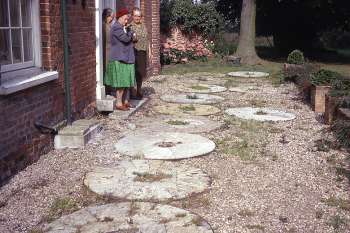 |
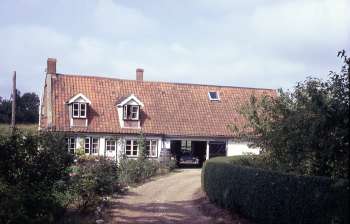 |
||
|
Millstones September 1967
|
Mill
cottage and mill remains September 1967
|
||
|
In 1967 the current owners still held insurance certificates for the mill dated 1771 |
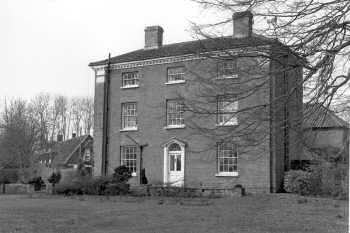 |
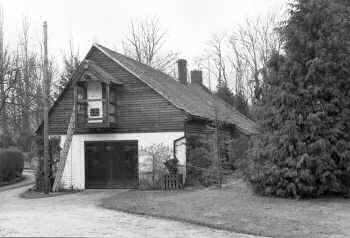 |
||
|
Mill house and mill remains beyond March 2003
|
Bungalow
on the mill base March 2003
|
||
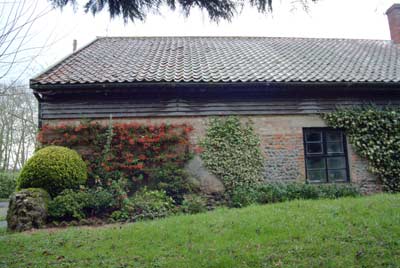 |
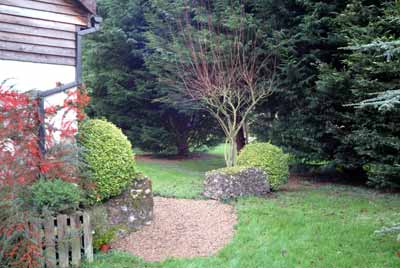 |
||
|
Original brickwork at rear of mill 13th November 2004
|
Part
of the wheelrace dam wall 13th November 2004
|
||
|
Up a very quiet lane and past a few modern cottages that Grandma told us were the old mill cottages that have been done up, we came to the Mill House. You have to go round a windy drive to get to it now, there used to be a direct gate from the road. Grandma remembered going along the path to visit Fanny and Betty. Grandma's father auctioned the mill house. |
|
When my father sold it, it was £1200 he got for it. But that's all the bit we see that the Seckers had, the wealthy Seckers, when they were with us, had added on that bit there, there was only originally this first bit. It's nice to see that where the old mill was they have got a barn
on it, or something, and it's got engraved on it B.P. Woolsey 1667 (48),
which is most interesting. We've just taken a photograph of that, of the
mill house, of course it's had extensions put on, and it looks very grand
now, but the old original part is still there. The front door was facing
this way but we can't see 'cos there's too many trees. |
|
"Isaac had built the Georgian front of the house. William married
again and they were married in the Quaker chapel 'cos they were Quakers." |
|
James Empson built the first Quaker Meeting House in 1692 but was burned down c.1770. Isaac Secker, who built the mill house also rebuilt the Meeting House in 1772. |
Benjamin Postle Woollsey, married Charlotte Gold on 22nd July 22 1823 in Gorleston. |
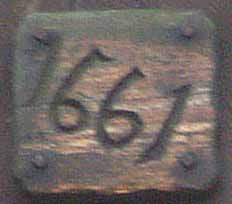 |
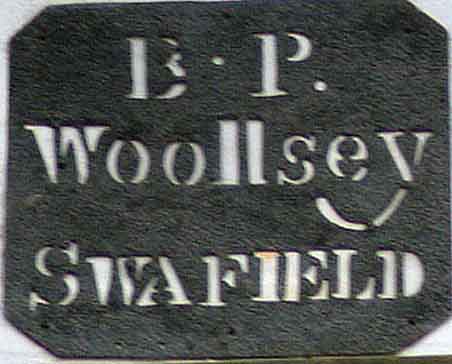 |
||
|
2
plaques on gable end balcony 13th November 2004
|
|||
|
The North Walsham & Dilham Canal |
| This was the
only official canal in Norfolk and was really the canalisation of the River
Ant. It was made wider than most other canals in order to accommodate Norfolk
wherries. The main cargoes were offal to the two Antingham
Bone mills with return loads of fertiliser. Corn and flour moved in
and out of Bacton Wood and Swafield mills
with other commodities such as timber, farm produce and coal making up the
majority of the remainder of trade. It was hoped that coal would be the
mainstay cargo but this never materialised. The canal was just over 8¾
miles long, ran from Smallburgh to Antingham and contained 6 locks: Honing,
Briggate mill, Ebridge
mill, Bacton Wood mill, Swafield lower
and Swafield Upper. 1812: Act of Parliament passed authorising construction of the canal July 1826: Canal opened having cost £32,000 to build 1885: Ailing canal sold for £600 but the company's London solicitor absconded with the money 1886: Scheme introduced to encourage tourist traffic c.1893: Antingham - Swafield section abandoned because of lack of traffic 1934: The wherry Ella, sailed from Bacton Wood Staithe for the last time 2003: Canal navigable for the first 2 miles as far as Honing Lock |
|
My grand father, John Elvin Hedge, came to America with his best friend Benjamin Woolsey.about 1916 give or take.on the Mauritania. I have the ships manifest. They also came with a Mr. Frary...which my grandfather married one of his daughters..Ethel.they all lived in upstate NY...The question I have is this....he always mention Swafield as his home town he being (John Hedge)..are there any Hedge families that still live there.........would love to know.......... |
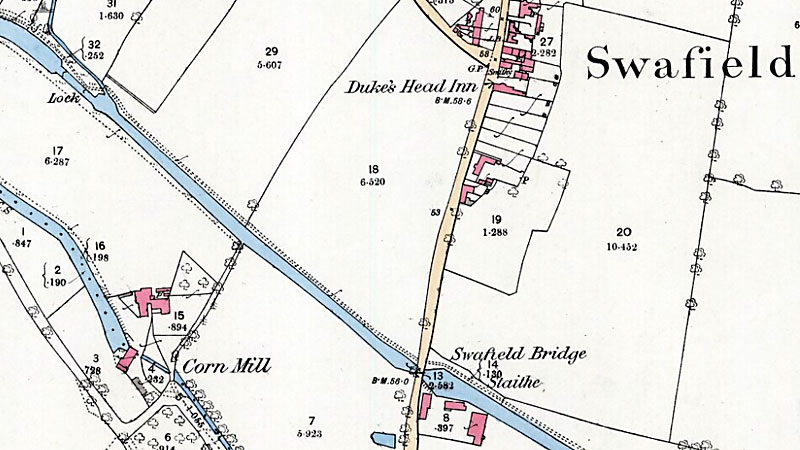 |
O. S. Map 1885 |
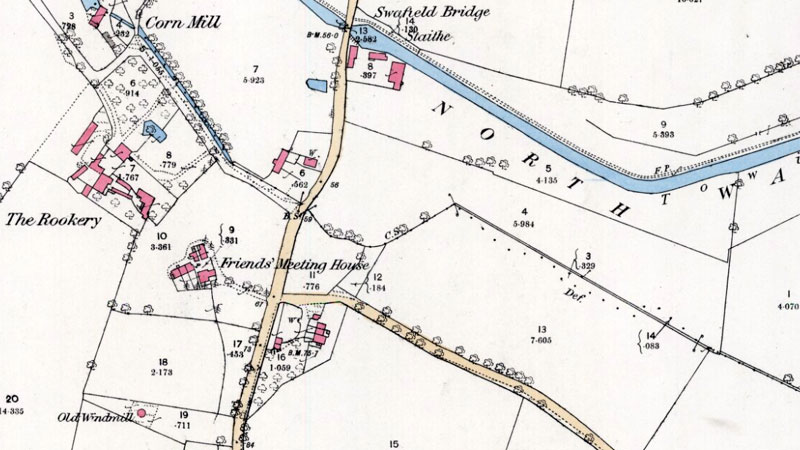 |
O. S. Map 1885 |
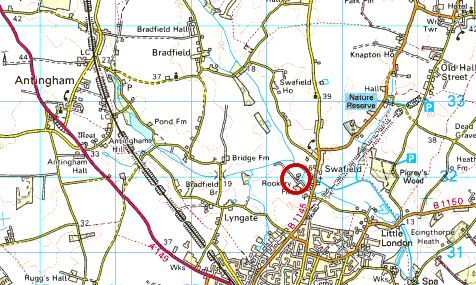 |
O.S. Map 2005 Image reproduced under licence from Ordnance Survey |
Kelly's 1879: John Woollsey, farmer |
|
1537: Pyford's
watermill let to William Hogan for £3.13s.4d. by the Bishop of Norwich
also Everbupe's mill
White's 1845: Benjamin Postle Woollsey, corn miller & merchant
White's 1854: Benjamin Postle Woollsey, corn miller & merchant |
If you have any memories, anecdotes or photos please let us know and we may be able to use them to update the site. By all means telephone 07836 675369 or
|
| Nat Grid Ref TG28403195 | Copyright © Jonathan Neville 2004 |